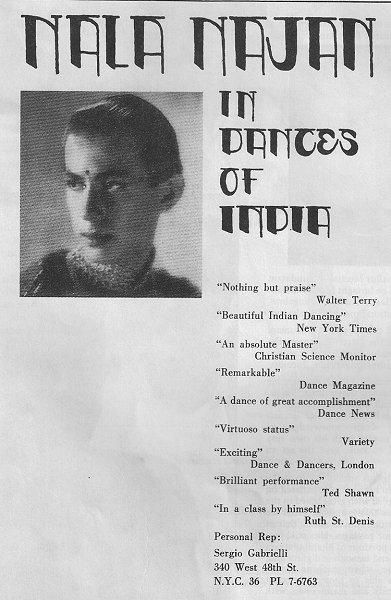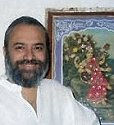
|   |

|   |
Nala Najan - Ashish Mohan Khokar, Bangalore e-mail: khokar1960@gmail.com Based on archival materials from The Mohan Khokar Dance Collection June 29, 2009 On June 28, 1932 Roberto Theodore Rivero was born in Pennsylvania to a Spanish mother and Russian father, settled in the USA. As a child, he was exposed to the violin and piano and to ballet but Bharatanatyam became his life. For this, he left USA on a boat going to Istanbul and from there, reached Malabar (Kerala) in 1947. From Malabar, he took a train to Madras and arrived at the doorstep of Mohan Khokar, to whom he had been connected by the father of Modern American Dance, Ted Shawn, who said, "In India, if anyone knows in-depth about all dances, not just southern or eastern forms, then go to Mohan Khokar." Nala corresponded with Mohan Khokar much before he set sail. Mohan Khokar, then also in Madras, was sharing one room barsati with Dandayudhapani Pillai in Adyar, and that was home for Nala too! Mohan Khokar advised him to learn from one of the finest masters of the form, Guru Muthukumaran Pillai of Kattumanarkoil, Chidambaram. This is the same master who taught giants of the form like Ram Gopal, Mrinalini Sarabhai, MK Saroja, Kamala Laxman, among others. Additionally, he learnt the violin and Bharatanatyam from Narayanaswamy Iyer also. Arriving in India in the late 1940s, he immersed himself whole-heartedly in learning Bharatanatyam. For this, like all others of his ilk and time, he based himself in Madras and later after his guru left Madras for his native place, he decided to follow him to Chidambaram to be at the feet of his Master. This spry lad from USA immersed totally into the art, dressing, talking and walking like the locals, so much so that because he was such a good "boy," the locals named him "nala" in Tamil meaning good. But Mohan Khokar and Dandayudhanpani felt the single short name was too short so they suggested he add Raja. As with most Tamil words, it got mauled to Rajam! Which Nala hated, so he stuck to Najan, to strike resemblance to Kalidasa's Shakuntalam. Thus, Nala Najan he became and remained. He did everything that rhymed! He talked fast, walked faster and danced fastest! His training in ballet gave him immense balance and his own sprightly frame was a big help for him to control each limb. His Bharatanatyam was exquisite and his costumes, regal. That was an era when men dressed regally, modelled after Ram Gopal and Uday Shankar. Nala Najan was a maverick, a man totally mad and besotted with Indian dance. His years spent learning in India, vested with him with much knowledge and authority that he later used when he turned a critic in New York. He first helped "Papa" Ted Shawn at Jacobs Pillow by introducing many Indian talents and some even go to perform there thanks to Nala Najan. Ted Shawn and wife, Ruth St. Denis, had visited India themselves in 1920s and seen dance art for themselves (fallen under British rule) and wished to help revive it by their own example and performances. Nala Najan's prodding enthused them further and they paid their debt back to India by promoting many Indian dancers, including Bhaskar Roy Chowdhury, Ritha Devi, and Nala settled in the USA. His stay in Tamilnad coincided with the time when revival of Indian dance was on. The nineteen forties were tumultuous times when new talents and trends were coming on stage. To put in historical context, Rukmini Devi had just had her debut and set the Adyar on fire, as a Brahmin doing Bharatanatyam and she arrived centre-stage in the forties when Bala the great, was in her element. Both were "positioned" somewhat in artistic duels, because certain lobbies placed them in that situation. Then there was E Krishna Iyer himself, who as lawyer-activist was in combat with Muthulakshmi Reddi, over the status of Devadasis. Heated discussions in the press, letters to important persons and debates made this duel very fulsome! To cut a very long battle short, in 1947 through an Act of the Legislative Assembly no less, the devadasis were abolished. They had thrown the baby with the bath water! Nala Najan was in India, in Madras when all this was happening so he saw history of the form being first made. He came in contact with all great dancers of the time: Bala, Ram, MK Saroja, Kamala Laxman, Kauslaya, Raji. He grew especially fond of Saroja and her family. He followed Saroja-Mohan Khokar to Baroda in 1950 where the couple were at the MS University. His constant smoking and talking and demand for endless cups of coffee made the young bride Saroja jittery, she recalls with affection. E Krishna Iyer came to Baroda to visit the Khokar couple (on invitation of Prof. Khokar, Head of Dance Dept) carrying an idli-stone sent by Saroja's mother, as in wilderness of wild west - Baroda, Gujarat of 1950s - where could an idli stone be found? Imagine the greatness and affection of scholars those days! Carrying an idli stone, weighing over 30 kg those days and bringing on a 5-day train trip from Madras to Baroda, with change of train in Bombay! Imagine Bharatanatyam's greatest catalyst and advocate doing that?   Nala Najan belonged to Indian soil. His soul anchored and blossomed here. Back in New York, he tried his hand (and feet) at dancing but several factors made him not succeed. First, men dancing those days were an oddity, even in New York of the 50s. Two, opportunities for "Hindu" dances were few. He survived in the sixties, helping Papa Shawn and Sol Hurok organise tours of visiting Indian artistes. Nala performed with Gina Blau at the Kauffman Auditorium in New York City in 1954. On April 17, 1955, he performed at the Henry Street Playhouse. Sarod maestro Ali Akbar Khan (who died recently) attended one of his shows with Pt. Chaturlal and complimented him and his associates Lalli, Yedida and Walter Nick. On September 20, he performed again at the Caravan Hall. Five days later he performed at Jacques Marchais Centre on Staten Island. "From here, no chronology... as I lost count," joked Nala when I interviewed him many years ago. His official debut took place on February 12, 1960 in New York City. The famous critic Walter Terry wrote in the New York Herald Tribune: "Nala Najan, an American youth who ran off to India to study first hand the ancient classical dances, made his formal debut…the auditorium was jammed. The program included cool classicism of Bharatanatyam... .a highly auspicious debut." Nala Najan also won high acclaim from other critics later like Richard V Happel (The Berkshire Eagle) and CR in The Springfield Union. Engagements in university circuits kept him busy through 1954-62. By 1962, Nala Najan was ready for another trip to India. This he did to learn Chhau. His dexterity also made him learn a very unknown form then, the Seraikella Chhau. For this he went to the village of Seraikella, with a letter of introduction from his close friend, Mohan Khokar. The Maharaja of Seraikella welcomed him and he was a state guest staying at the Palace. In return, many years later, Nala Najan was instrumental in the Seraikella Chhau dancers touring the USA, with Nala himself providing expert introductions. He was the first promoter of the form and enlisted Sol Hurok no less, as impresario to help the form reach many in the USA. His introductions and commentary on each dance form was very useful because way back then Indian dances were not well known and clubbed with Oriental or Hindu dances, the snake-charmer types. Nala Najan put India on the world dance map in USA academically, it can be said without hesitation. In the seventies, Nala Najan became a full time critic, his dancing career behind him due to several reasons, not least economic. Though he remained a devotee of dance, he took to writing and wrote extensively, including for main stream newspapers and journals like Arabesque, Rasamanjari, Sruti and Attendance. His articles were well researched, deep and full of facts. He additionally taught Shrimathi Gina, Lalli, Joan Klick, Carola Goya, Hadassah, Sasha, Raja and Evana. He also taught padams and javalis to those keen to learn like Uttara Coorlawala and Kathak dancer Janaki Patrik helped him a lot. Bhaskar Roy Chowdhury and Ritha Devi remained his close partners of the dance scene and both provided him with company and camaraderie. In 1981, he also won the 5th Ruth St. Denis Award instituted by La Meri, his other benefactor and inspiration. Nala Najan had strong likes and dislikes and this was used against him by certain people who wanted to marginalize him but he stood by his muse and served it till his end on January 7, 2002. He died surrounded by his friends and servers like Mark Trainor, who looked after him in the end years. Nala Najan will always be remembered as a pioneer who was foreigner by birth but Indian of soul. Dance history of India will remember him with fondness. Responses  Ashish Mohan Khokar takes special delight in reconstructing dance history. His own Masters in Indian History (merit lister, Delhi University) helps him in this process as also his inheritance, born as he is to the most distinguished dance family. His father created India's largest dance archives, materials from which now helps him save and serve; rewrite and reconstruct dance history of India. His own world vision (having practically handled many high level projects all over Europe and America) and vast exposure to variety of cultural administration and involvement at home in India, have furthered the process of making him unparalleled, in his generation. He has watched dance for almost 45 years now born to a legendary dance mother, and written about it in last 30 as critic of leading publications (Times, India Today), in addition to his own over 35 books and editing-publishing India's only yearbook on dance, attendance. attendance-india.com |